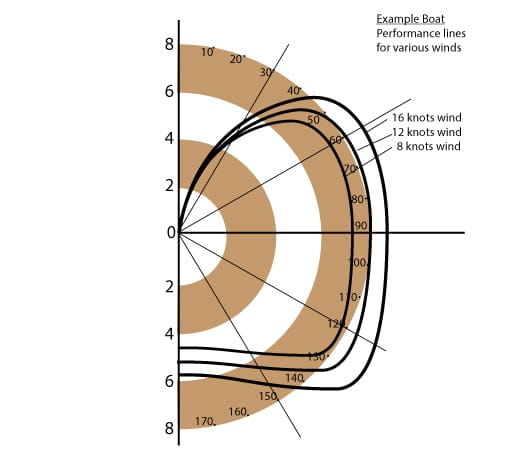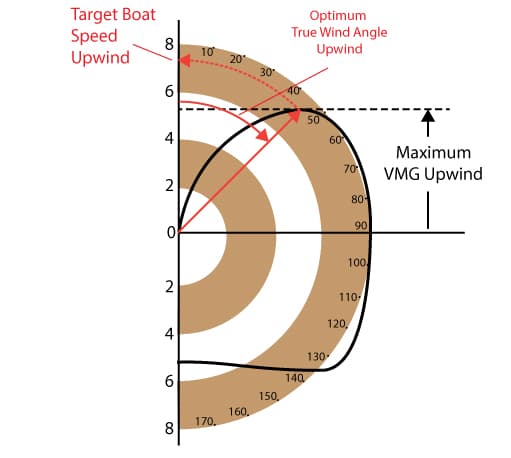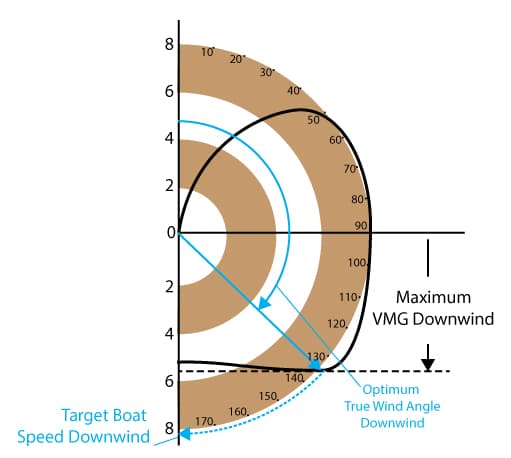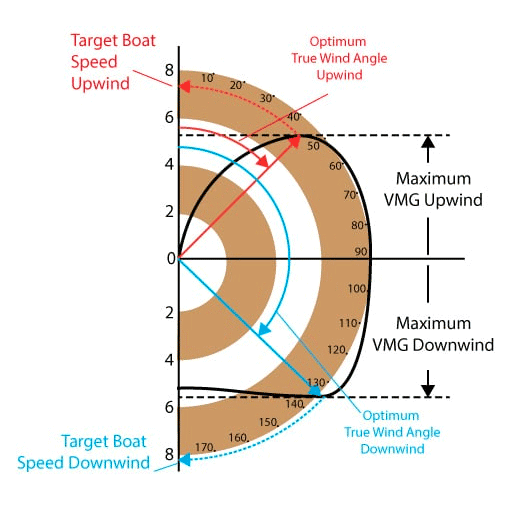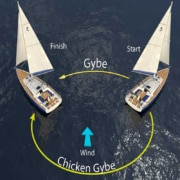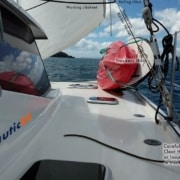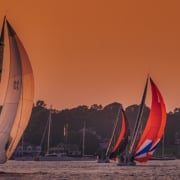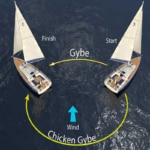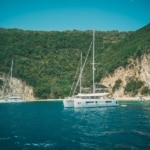This is an excerpt from the NauticEd Electronic Navigation Course. The course is FREE when you buy the Bareboat Charter Master bundle of courses. Or a la carte, it is only $25. In this section, we are discussing Max VMG – that is the Max Velocity Made Good towards an upwind or downwind destination, the optimum true wind angles to sail, and how to use polar plots to attain these important numbers.
The polar plot is the navigator’s friend. It’s essentially a graph that shows how fast your boat can go in a range of wind speeds and angles. Polar plots are published by each manufacturer for each model of boat with their various sail plans. Below is an example of one particular boat for three true wind speeds; 16 knots, 12 knots, and 8 knots.
HOW TO READ A POLAR PLOT
Move your finger radially along any true wind angle. Stop when you reach the boat performance line associated with the true wind speed you are experiencing. Now, read back around the concentric boat speed circles to the vertical axis and read off the expected performance boat speed (through the water) for that given true wind angle and that given true wind speed. This is the speed at which your boat “should” be sailing and is the speed to which your sail trimmers should try to achieve: the target boat speed.
For example: If you were traveling at 60 degrees off the wind, below would be your boat speeds (through the water) at the various wind speeds:
- 16 knots wind: 8.8 knots boat speed
- 12 knots wind: 8.2 knots boat speed
- 8 knots wind: 7.2 knots boat speed
Observe the following animation. Click on any TWA (true wind angle) on the right and watch:
- The boat icon move to that position on the polar plot
- The wind meter boat speed and TWA
Additionally, what is great about this is that the optimum true wind angle for upwind and downwind legs are easily found by drawing a horizontal line at the highest polar point for upwind and the highest for downwind. In this case, you are maximizing your VMG (Velocity Made Good in the direction of the true wind).
In the plot below, for the 12-knot wind speed example, the max VMG is 5.2 when the boat is properly trimmed, sailing at 7.4 knots through the water and sailing at 45 degrees off the true wind. When sailing at any other angle, the VMG will decrease. If you sail closer to the wind, you are sailing a better angle but your VMG drops along with your boat speed. If you “crack off” the wind a little, your boat speed goes up but your VMG decreases because you are sailing a worse angle. For an upwind course then, the optimum true wind angle for the boat is the highest point the curve reaches because you are maximizing your VMG in the upwind direction.
In this example, when sailing upwind, the optimum true wind angle is 45 degrees (aka Target True Wind Angle) and the Target Boat Speed is 7.4 knots. Thus, upwind, the navigator calls to the helms person to steer 45 degrees to the true wind and tells the trimmers to trim to attain 7.4 knots of boat speed through the water (not SOG).
Downwind, the optimum (target) true wind angle is 135 deg and the target boat speed is 8.1 knots.
It can be easily determined from the above plot that a downwind heading to a downwind destination is not the fastest way to get to the downwind destination, instead, head off a little and do several gybes. But how much to head off?
In the polar plot example shown, a horizontal line that touches the max boat speed touches at 135 degrees. At this point, reading around the concentric circle, the boat speed is 8.1 knots (assuming it is properly trimmed). Reading across to the vertical line the VMC is 5.7 knots. Comparatively, another sailor that takes a course directly downwind would achieve a boat speed and VMC of 5.0 knots.
In the video below, we sail the boat at specific angles and measure the speed. Then we compare those speeds with the polar plot of the boat. We also show you through a polar plot so that you can exactly understand how one works.
If you’re getting stuck on this a little, don’t worry too much. The two main points to understand are the optimum upwind true wind angle and the optimum downwind true wind angle.
Some units have built-in example polar plots which you can change and add to match your boat. Although, you might ask your installation specialist to input these for you.
To learn more, register for the NauticEd Electronic Navigation Course ›
### Updated 11/23/2022

